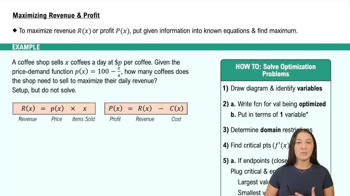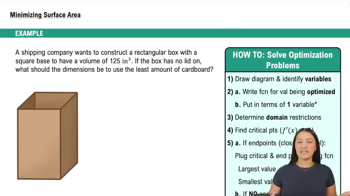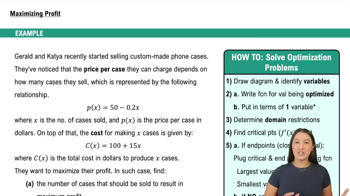Table of contents
- 0. Functions7h 52m
- Introduction to Functions16m
- Piecewise Functions10m
- Properties of Functions9m
- Common Functions1h 8m
- Transformations5m
- Combining Functions27m
- Exponent rules32m
- Exponential Functions28m
- Logarithmic Functions24m
- Properties of Logarithms34m
- Exponential & Logarithmic Equations35m
- Introduction to Trigonometric Functions38m
- Graphs of Trigonometric Functions44m
- Trigonometric Identities47m
- Inverse Trigonometric Functions48m
- 1. Limits and Continuity2h 2m
- 2. Intro to Derivatives1h 33m
- 3. Techniques of Differentiation3h 18m
- 4. Applications of Derivatives2h 38m
- 5. Graphical Applications of Derivatives6h 2m
- 6. Derivatives of Inverse, Exponential, & Logarithmic Functions2h 37m
- 7. Antiderivatives & Indefinite Integrals1h 26m
- 8. Definite Integrals4h 44m
- 9. Graphical Applications of Integrals2h 27m
- 10. Physics Applications of Integrals 2h 22m
5. Graphical Applications of Derivatives
Applied Optimization
Problem 4.3.109b
Textbook Question
{Use of Tech} Demand functions and elasticity Economists use demand functions to describe how much of a commodity can be sold at varying prices. For example, the demand function D(p) = 500 - 10p says that at a price of p = 10, a quantity of D(10) = 400 units of the commodity can be sold. The elasticity E = dD/dp p/D of the demand gives the approximate percent change in the demand for every 1% change in the price. (See Section 3.6 or the Guided Project Elasticity in Economics for more on demand functions and elasticity.)
b. If the price is $12 and increases by 4.5%, what is the approximate percent change in the demand?
 Verified step by step guidance
Verified step by step guidance1
First, identify the demand function given in the problem: D(p) = 500 - 10p.
Next, calculate the derivative of the demand function with respect to price p, which is dD/dp. For D(p) = 500 - 10p, the derivative dD/dp = -10.
Now, use the formula for elasticity E = (dD/dp) * (p/D). Substitute dD/dp = -10, p = 12, and D(12) = 500 - 10*12 = 380 into the formula.
Calculate the elasticity E at p = 12 using the values obtained: E = (-10) * (12/380).
Finally, use the elasticity to find the approximate percent change in demand for a 4.5% increase in price. Multiply the elasticity E by the percent change in price (4.5%) to get the percent change in demand.
 Verified video answer for a similar problem:
Verified video answer for a similar problem:This video solution was recommended by our tutors as helpful for the problem above
Video duration:
3mPlay a video:
Was this helpful?
Key Concepts
Here are the essential concepts you must grasp in order to answer the question correctly.
Demand Function
A demand function expresses the relationship between the price of a commodity and the quantity demanded by consumers. It is typically represented as D(p), where D is the quantity demanded and p is the price. For instance, in the function D(p) = 500 - 10p, the quantity demanded decreases as the price increases, illustrating the law of demand.
Recommended video:

Properties of Functions
Elasticity of Demand
Elasticity of demand measures how sensitive the quantity demanded is to a change in price. It is calculated using the formula E = (dD/dp) * (p/D), where dD/dp is the derivative of the demand function with respect to price. A higher elasticity value indicates that demand is more responsive to price changes, which is crucial for understanding consumer behavior.
Recommended video:

Maximizing Profit & Revenue
Percent Change Calculation
Percent change is a way to express the change in a quantity relative to its original value, calculated as (new value - old value) / old value * 100%. In the context of demand elasticity, it helps determine how much the demand will change in response to a percentage change in price, providing insights into market dynamics.
Recommended video:

Changing Geometries

 1:13m
1:13mWatch next
Master Intro to Applied Optimization: Maximizing Area with a bite sized video explanation from Callie
Start learningRelated Videos
Related Practice








